While it is becoming increasingly likely that the Mets will be sellers at the deadline, the team won’t be going into a full fire sale. Noah Syndergaard and Steven Matz are two of the names that aren’t likely to be going anywhere before the July 31st deadline, as Mike Puma of the New York Post hears from an industry source that the Mets “would likely have to be overwhelmed by a trade proposal” to deal Syndergaard or Matz.
The Mets’ reluctance to move Syndergaard is well-known, despite the fact that at least three teams (the Brewers, Astros and Padres) have shown interest already, and several more would surely join the bidding if the man they call Thor was actually shopped. We haven’t heard much about Matz as a trade candidate this summer, and it’s interesting that he is seemingly in the same boat as the more heralded Syndergaard, though New York would have largely the same reasons to want to keep either pitcher.
Matz has a 4.89 ERA, 2.69 K/BB rate, 46.9% grounder rate, and 8.7 K/9 over 81 innings this season. Despite some pretty decent overall advanced metrics, Matz has been once again undone by problems with the home run ball. After posting a 1.5 HR/9 in 2017-18, that number jumped even higher to a full 2.0 HR/9 in 2019, as 20.9% of all fly balls allowed by Matz have left the yard. Matz’s struggles peaked in June, as a string of poor outings led the Mets to remove him from the rotation, though he is slated to start on July 17 against the Twins.
Now in his fourth season as a regular, Matz has shown some flashes of brilliance for the Mets but injuries and his propensity for the home run ball have limited his value. After generating 2.4 fWAR in his 2016 rookie season, he has been little more than a replacement-level pitcher since, with 1.3 total fWAR over his next 301 2/3 innings. Matz hasn’t approached the type of ace-level ability Syndergaard has shown at his peak, though like Syndergaard, the Mets would arguably be selling low on Matz if they dealt him now.
Matz is in his first year of arbitration eligibility, earning $2.625MM for the season and thus in line for cost-effective salaries in both 2020 and 2021 even if Matz has a breakout next year. Syndergaard also has two-plus years of team control remaining, though at a higher price (he is earning $6MM in 2019). Between the control and the lack of payroll strain caused by either hurler, the Mets don’t have any particular reason to make a trade, especially since neither is pitching particularly well.


